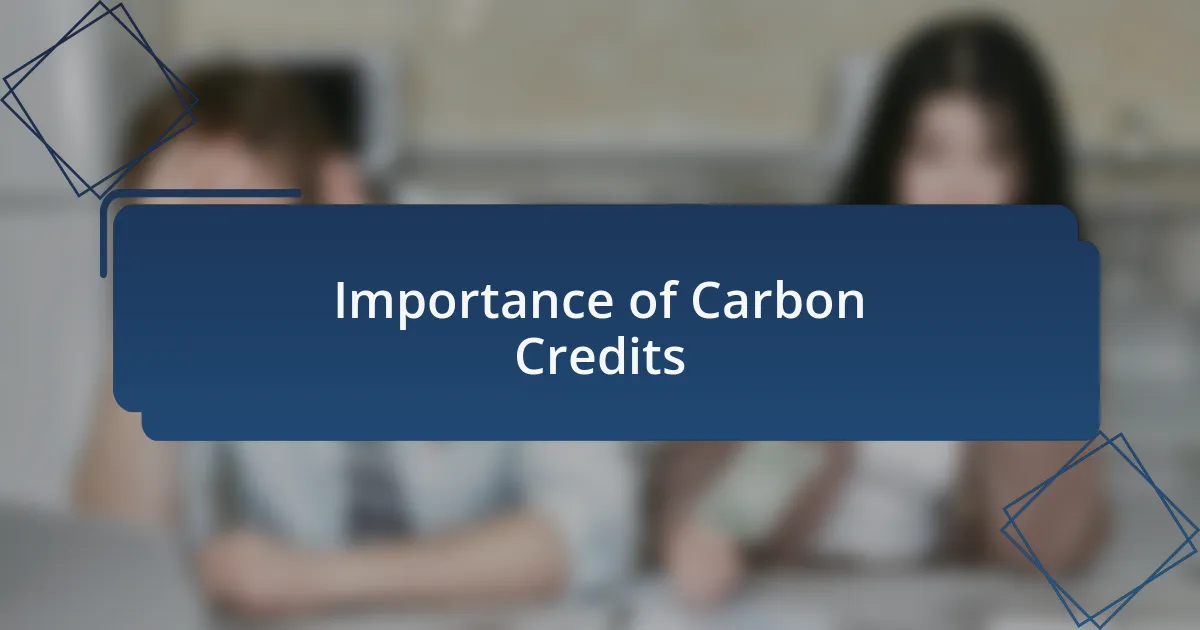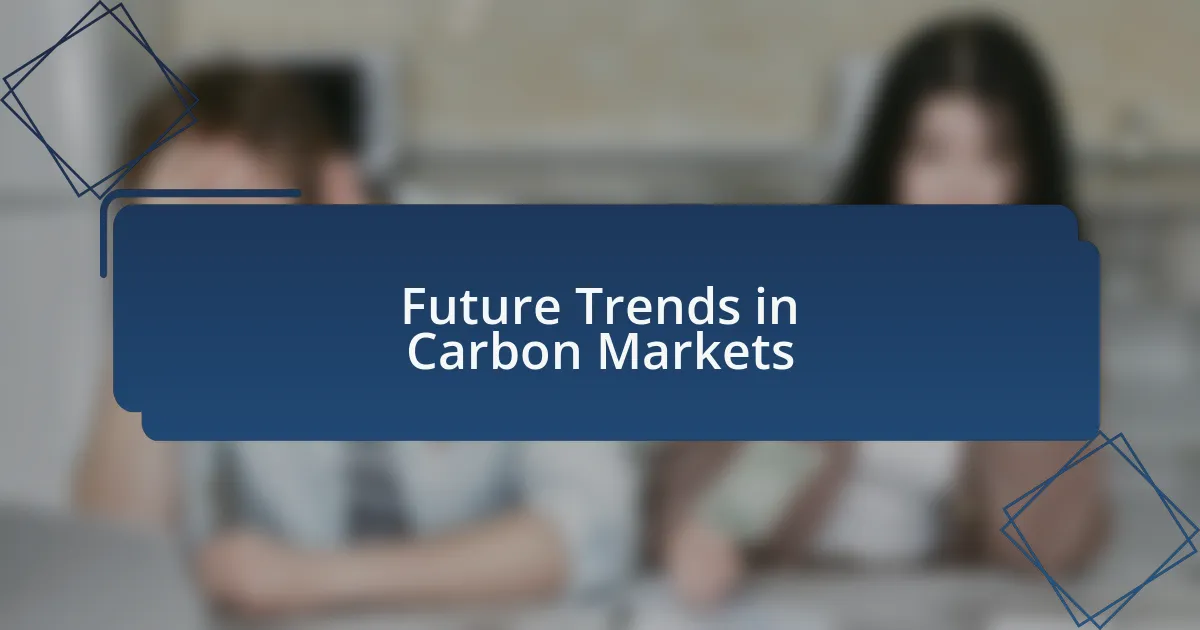Key takeaways:
- Eco-friendly finance aligns financial goals with sustainable practices, empowering individuals to make conscious spending decisions that benefit the environment.
- Carbon markets facilitate the trading of carbon credits, providing economic incentives for companies to reduce emissions through mechanisms like cap and trade.
- Carbon credits are crucial for fostering innovation and supporting sustainability efforts, enabling businesses to offset emissions while contributing to ecological projects.
- The future of carbon markets may be shaped by technology integration, increased voluntary participation, and the adoption of carbon pricing mechanisms.

Understanding Eco-Friendly Finance
Eco-friendly finance revolves around making financial decisions that support sustainable practices and reduce environmental harm. It’s fascinating to think about how our investments can directly impact the health of our planet. I remember when I first discovered how choosing a green investment fund could align my financial goals with my values; it felt empowering to know that my money could work towards a better future.
Consider the profound effect that conscious spending has on both the environment and our communities. When I started researching eco-friendly finance options, I felt a sense of responsibility to understand where my money was going and how it could contribute to sustainable development. Isn’t it inspiring to contemplate how even small changes in our spending habits can collectively lead to significant positive change?
Moreover, eco-friendly finance encompasses a wide range of strategies, from green bonds to ethical consumerism. What surprised me was learning about the scalability of these concepts. I often find myself wondering how more people can be educated about these options. The potential for impact grows when more individuals invest in sustainability, illuminating the interconnectedness of our financial choices and environmental outcomes. This realization encourages me to be an advocate for eco-friendly finance in my everyday life.

Introduction to Carbon Markets
Carbon markets play a crucial role in addressing climate change by providing a framework for trading carbon emissions. When I first learned about how these markets operate, I found it intriguing that companies and countries can buy and sell carbon credits, allowing them to meet their emissions goals while also engaging in a market-driven approach. It raised a thought: how can something as abstract as a carbon credit translate into tangible environmental benefits?
What struck me was the concept of “cap and trade,” where a limit is set on emissions, and companies that reduce their output can sell their extra allowances. This system not only incentivizes innovation but also creates financial opportunities for businesses willing to invest in greener technologies. I often pondered if this approach could be expanded in more sectors, to amplify its impact on overall emissions.
Understanding the dynamics of carbon markets deepened my appreciation for their potential, as they connect economic growth with environmental sustainability. While studying this topic, I felt a sense of urgency; every transaction in a carbon market signals a choice for the planet. I began to realize how critical it is for more individuals and businesses to engage in this system, as our participation can lead to meaningful change in reducing the carbon footprint globally.

Importance of Carbon Credits
The importance of carbon credits cannot be overstated, as they serve as a financial incentive for reducing greenhouse gas emissions. I distinctly remember attending a sustainability seminar where an expert described carbon credits as “not just a piece of paper, but a lifeline for the planet.” This perspective resonated deeply with me. It’s fascinating to think that by investing in carbon credits, companies can actively contribute to reforestation or renewable energy projects, turning their commitment into concrete ecological benefits.
Moreover, carbon credits play a pivotal role in fostering innovation. I recall a conversation I had with a friend who runs a clean-energy startup. He mentioned that being able to sell carbon credits significantly eased the financial burden of implementing new technologies. This made me realize how essential these credits are for encouraging businesses, especially startups, to take the leap into sustainability. If companies see financial gain from reducing their emissions, why wouldn’t they invest in greener practices?
Ultimately, buying carbon credits empowers individuals and corporations alike to take responsibility for their ecological footprint. Reflecting on my own choices, I began to wonder: how can I leverage carbon credits in my daily life? This question led me to consider the broader impact of individual actions. By participating in the carbon market, each of us can contribute to a collective effort to combat climate change, and that’s a powerful thought to carry forward.

How Carbon Markets Work
Understanding how carbon markets function is both intriguing and vital. At their core, carbon markets operate on the principle of trading carbon credits, certificates representing the right to emit one ton of carbon dioxide or its equivalent in other greenhouse gases. This exchange creates a financial system where companies can buy and sell these credits, effectively putting a price on carbon emissions and encouraging reductions.
I’ve found it fascinating how these markets can incentivize real change. For instance, when I first learned that companies facing difficulties in meeting their emission targets can purchase credits to offset their excess emissions, it changed my perspective. It’s like a balance sheet for the environment—businesses are motivated to lower their emissions when it becomes economically beneficial. Have you ever thought about how much more competitive companies become when sustainability is tied to their bottom line?
Moreover, it’s noteworthy that carbon markets can vary globally. In some regions, governmental bodies set a cap on emissions and allow trading of credits among companies, while others focus on voluntary markets driven by corporate social responsibility. I remember discussing this variation with a colleague who works in policy. We mused about how these differences affect overall climate goals and the collective responsibility we all have in making our planet healthier. It’s incredible to think that our choices in buying carbon credits can ripple out into larger environmental impacts.

Personal Insights on Carbon Trading
When I first delved into carbon trading, I was surprised by the complexities involved. I vividly remember attending a workshop where experts debated the efficacy of various carbon markets. Listening to their differing opinions made me appreciate how nuances in regulation can significantly influence the effectiveness of these markets. Have you ever considered how a small policy change could shift an entire market?
A personal experience that stands out to me occurred during a project I was involved in, where our team decided to purchase carbon credits as a part of our sustainability strategy. I felt a sense of pride knowing that our efforts would financially support projects focused on reforestation. It was an emotional moment, realizing that our financial decisions could contribute to restoring ecosystems. I often wonder how many more businesses can harness this opportunity for positive impact.
Furthermore, engaging with local companies about their carbon trading strategies has shown me the diverse motivations driving participation in these markets. One business owner told me that the financial incentives were indeed compelling, but the real driver was a genuine commitment to combating climate change. Isn’t it uplifting to see how economic strategies can align with personal values, creating a win-win situation for both business and the environment?

Lessons from Carbon Market Experiences
The lessons I’ve extracted from my experiences in carbon markets are truly enlightening. For instance, I remember working closely with a nonprofit that managed emissions reduction projects. Witnessing firsthand how transparent communication between stakeholders can foster trust was eye-opening. I now believe that transparency isn’t just a regulatory tick box; it’s essential for building robust relationships and ensuring the long-term success of carbon initiatives.
Another critical lesson centers on adaptability. I recall a project where we faced unexpected challenges due to regulatory changes. It taught me that flexibility is paramount in carbon trading. How can businesses pivot effectively if they’re too rigid in strategy? I found that embracing change often opens doors to innovative solutions, allowing us to navigate obstacles while still meeting our environmental targets.
Ultimately, the emotional connection to the mission behind carbon trading has been one of the most profound insights for me. During a recent panel discussion, a participant shared a heartfelt story about how trading emissions credits transformed his local community. Hearing him express his passion made me realize that these markets are not just about numbers but about real people and their futures. Isn’t it powerful to know that each transaction could mean cleaner air and a healthier planet for all?

Future Trends in Carbon Markets
As I look ahead to the future of carbon markets, a trend that excites me is the integration of technology. For example, I recently attended a conference where innovators showcased blockchain solutions that enhance traceability in carbon credits. Imagine a world where every credit can be traced back to its origin, creating a level of transparency that reassures investors and consumers alike—doesn’t that sound like a game-changer?
Another aspect that I find fascinating is the shift towards voluntary carbon markets. While compliance markets have their place, the increase in corporate sustainability goals is pushing many companies to invest in voluntary credits. I remember a conversation with a sustainability manager at a leading firm who shared that their internal initiatives were boosted by purchasing offsets from local projects. It made me ponder—how many companies might follow suit, making a tangible difference while saving face with their eco-conscious consumers?
Lastly, I believe that the rise of carbon pricing mechanisms will continue to gain momentum. Reflecting on days spent with policymakers, I learned how effective pricing can incentivize emission reductions while funding renewable projects. It left me wondering: how quickly can we shift industries away from fossil fuels if this pricing becomes universally accepted? The convergence of education, policy, and market demand could shape a more sustainable future, and I’m eager to see how soon those changes can unfold.